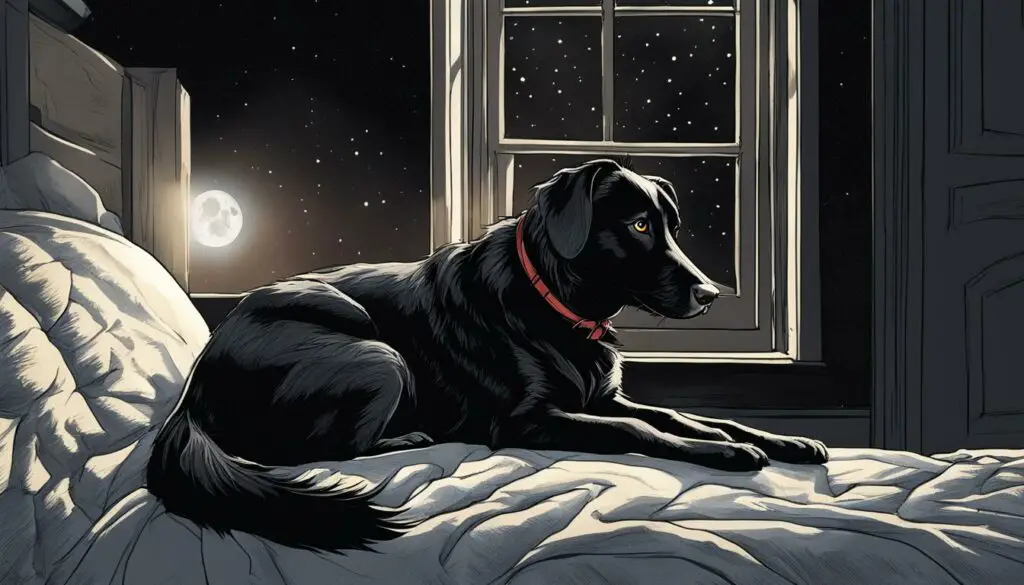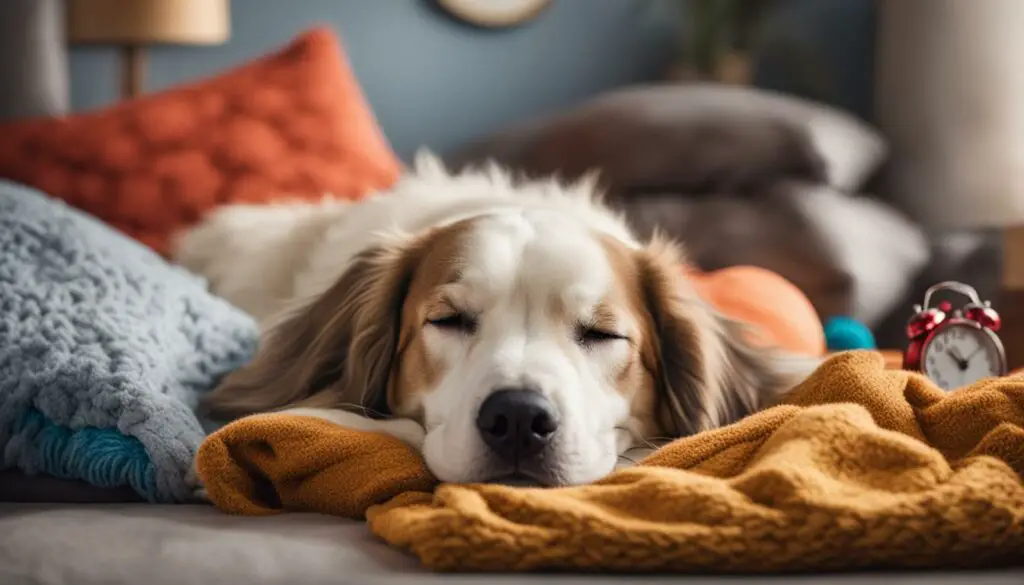Many dog owners struggle with the challenge of getting their furry friends out of bed in the morning. Whether it’s due to anxiety, pain, or a simple desire for comfort, there are various reasons why dogs might resist leaving their beds. In this article, we will explore the different factors that can contribute to a dog’s reluctance to get out of bed and provide some effective tips to motivate them to start their day.
Key Takeaways:
- Dogs may resist getting out of bed due to anxiety, pain, or a desire for comfort.
- Understanding the underlying cause is crucial for addressing your dog’s reluctance.
- Consult with a veterinarian to determine the best approach for motivating your dog.
- Creating a comfortable sleeping environment and establishing a routine can help encourage your dog to start their day.
- Positive reinforcement training techniques can be effective in motivating dogs to leave their beds.
Understanding Senior Dog’s Nighttime Anxiety
Many senior dogs experience nighttime anxiety, which can be distressing for both the dog and their owner. Understanding the causes of this anxiety is the first step in finding effective solutions to help alleviate their symptoms and provide them with a more peaceful sleep. There are several potential factors that contribute to nighttime anxiety in older dogs, including cognitive dysfunction syndrome, pain, and other underlying health conditions.
One of the primary causes of nighttime anxiety in senior dogs is cognitive dysfunction syndrome (CDS), a condition similar to Alzheimer’s disease in humans. Dogs with CDS may experience confusion, disorientation, and changes in behavior, which can intensify during the night when they are trying to sleep. Additionally, pain from conditions such as arthritis can contribute to anxiety, as older dogs may find it uncomfortable to get comfortable in their sleeping positions. Other health issues, such as urinary tract infections or gastrointestinal problems, can also cause nighttime restlessness and anxiety.
To address nighttime anxiety in senior dogs, it is crucial to work closely with a veterinarian to determine the underlying cause and develop a tailored treatment plan. This may involve medication to manage pain or anxiety, environmental modifications to create a calm and comfortable sleep environment, and behavioral interventions to reduce anxiety-related behaviors. The ultimate goal is to help senior dogs feel safe, secure, and relaxed during their nighttime rest, leading to improved overall wellbeing and a better night’s sleep for both the dog and their owner.

Causes of Anxiety in Senior Dogs at Night
Table: Common Causes of Anxiety in Senior Dogs at Night
| Cause | Symptoms |
|---|---|
| Cognitive Dysfunction Syndrome (CDS) | Confusion, disorientation, changes in behavior |
| Pain from arthritis or other health conditions | Restlessness, difficulty finding a comfortable position |
| Underlying health issues (e.g., urinary tract infections, gastrointestinal problems) | Increased restlessness, frequent waking up |
In conclusion, understanding the factors contributing to senior dog’s nighttime anxiety is crucial in providing them with the care and support they need. By working closely with a veterinarian and implementing appropriate interventions, it is possible to help alleviate their anxiety symptoms and improve their overall sleep quality. A well-rested senior dog can enjoy a better quality of life, and their owner can also benefit from a more peaceful night’s sleep.
Diagnosing Anxiety in Senior Dogs
Understanding and diagnosing anxiety in senior dogs is essential for providing them with the necessary support and treatment. Veterinary expertise plays a vital role in accurately identifying and addressing anxiety in these beloved pets. To diagnose anxiety, vets rely on a comprehensive examination that includes a detailed history-taking and physical assessment. Observations provided by owners add valuable insight into a dog’s nighttime routines, behavior changes, and potential triggers.
The diagnostic process involves close collaboration between veterinarians and dog owners. By actively observing and documenting their dog’s behaviors, owners contribute to the identification of anxiety patterns and triggers. This information enables vets to create a tailored treatment plan that addresses the specific needs of each individual dog. A thorough veterinary diagnosis is crucial in providing effective strategies to manage anxiety and improve the overall well-being of senior dogs.
Importance of Veterinary Diagnosis in Managing Anxiety
Seeking a veterinary diagnosis is of utmost importance when dealing with anxiety in senior dogs. Through a comprehensive examination, vets can differentiate anxiety from other potential causes of distress and recommend appropriate treatment options. Diagnosing anxiety involves assessing the dog’s symptoms, behavior patterns, and potential triggers, taking into account their overall health and medical history. Veterinary expertise is vital in identifying the root cause of anxiety and developing an evidence-based treatment plan.
Remember, if you notice any signs of anxiety in your senior dog, consult with your veterinarian for a proper diagnosis and guidance. By working together, you can provide the best possible care to help alleviate anxiety and improve the quality of life for your beloved furry companion.

| Signs of Anxiety in Senior Dogs | Potential Causes |
|---|---|
| Panting | Cognitive dysfunction syndrome |
| Pacing | Pain due to arthritis or other health conditions |
| Whining | Underlying medical issues |
| Restlessness | Changes in the environment |
Note: The table above provides a general overview of common signs of anxiety in senior dogs and potential causes. However, it is crucial to consult with a veterinarian for an accurate diagnosis and personalized treatment plan.
Causes of Anxiety in Senior Dogs at Night
Senior dogs can experience anxiety at night due to various reasons, which can significantly impact their quality of life. Understanding the causes of nighttime anxiety in older dogs is essential in providing appropriate care and support for their well-being. Some common reasons for nighttime anxiety in senior dogs include:
- Cognitive Dysfunction Syndrome (CDS): Similar to Alzheimer’s disease in humans, CDS can cause confusion, disorientation, and changes in behavior, leading to anxiety in senior dogs.
- Pain and Discomfort: Conditions such as arthritis, muscle stiffness, or other underlying health issues can cause pain and discomfort, leading to increased anxiety during nighttime.
- Environmental Changes: Older dogs may struggle with changes in their surroundings, such as moving to a new home, unfamiliar noises or smells, or disruptions in their routine, which can trigger anxiety.
- Loss of Sensory Function: As dogs age, their sensory functions may decline, leading to heightened anxiety as they become more reliant on their remaining senses.
Identifying the specific cause or triggers of nighttime anxiety in senior dogs is essential for developing an effective treatment plan and helping them feel more secure and relaxed during the night. Consulting with a veterinarian can provide valuable insights and guidance in addressing these underlying causes and reducing anxiety in older dogs.
How to Support Senior Dogs with Nighttime Anxiety
When dealing with nighttime anxiety in senior dogs, it’s crucial to create a comfortable and soothing environment that promotes relaxation and reduces stress. Here are some tips to help support senior dogs with nighttime anxiety:
- Provide a cozy and quiet sleeping area away from distractions.
- Establish a regular routine to help senior dogs feel more secure and anticipate nighttime activities.
- Use soothing techniques such as calming music, aromatherapy, or a weighted blanket to promote relaxation.
- Consider providing a safe space or crate where the dog can retreat to if they feel anxious or overwhelmed.
- Consult with a veterinarian to explore potential medication or natural remedies that can help alleviate anxiety symptoms.
By understanding the underlying causes of nighttime anxiety in senior dogs and implementing supportive strategies, it’s possible to improve their overall well-being and help them have a more peaceful and restful night’s sleep.

Treating Senior Dogs with Nighttime Anxiety
Managing nighttime anxiety in older dogs requires a comprehensive approach that addresses both the physical and emotional well-being of our furry friends. Here are some effective strategies for treating senior dogs with anxiety at night:
- Medication: In some cases, veterinarians may prescribe medication to help alleviate anxiety symptoms in senior dogs. These medications can help calm their nerves and promote a more restful sleep.
- Behavioral Modifications: Implementing behavioral modifications can be beneficial in reducing nighttime anxiety. This may include creating a relaxing bedtime routine, using calming music or pheromone diffusers, and providing comforting items like a favorite blanket or toy.
- Environmental Changes: Creating a safe and secure sleeping environment can help senior dogs feel more at ease. This may involve using nightlights to reduce shadows, blocking out excessive noise, or adjusting the temperature to ensure optimal comfort.
- Alternative Therapies: Some senior dogs may benefit from alternative therapies such as acupuncture or massage. These treatments can help promote relaxation, reduce pain, and improve overall well-being.
It’s important to consult with a veterinarian to determine the most appropriate treatment options for your individual dog. Every dog is unique, and what works for one may not work for another. By following a personalized treatment plan, you can help your senior dog manage their nighttime anxiety and enjoy a peaceful night’s sleep.

Expert Tip:
“While medication can be helpful in managing nighttime anxiety, it should always be used in combination with behavioral modifications and environmental changes. This holistic approach provides the best chance of success in alleviating anxiety symptoms and improving the overall well-being of senior dogs.” – Dr. Amanda Thompson, Veterinarian
| Treatment Options | Benefits |
|---|---|
| Medication | Calms nerves and promotes restful sleep |
| Behavioral Modifications | Reduces anxiety through a relaxing bedtime routine and comforting items |
| Environmental Changes | Creates a safe and secure sleeping environment |
| Alternative Therapies | Promotes relaxation, reduces pain, and improves overall well-being |
By implementing these treatment options and working closely with your veterinarian, you can help your senior dog find relief from nighttime anxiety and enjoy a better quality of life.
The Importance of Sleep for Dogs and Owners
Sleep is essential for the overall health and well-being of both dogs and their owners. Just like humans, dogs require proper rest to function at their best. Adequate sleep promotes physical and cognitive functioning, emotional stability, and a strong immune system. When dogs don’t get enough sleep, it can have a negative impact on their behavior, energy levels, and overall quality of life. It’s important to prioritize and ensure that our furry friends have a comfortable and restful sleep environment.
For dogs, a good night’s sleep provides several benefits. It helps them recharge their energy levels, allowing them to be more active and alert during the day. Sleep also plays a vital role in the brain development and processing of information for both puppies and adult dogs. Furthermore, quality sleep promotes muscle repair, growth, and overall physical recovery from daily activities. It contributes to a healthier immune system, reducing the risk of illness and supporting faster healing of any existing health conditions.

Not only does sleep benefit dogs, but it also has positive effects on their owners. When dogs are well-rested, they tend to exhibit calmer behavior and are more likely to follow commands. This creates a peaceful and harmonious environment for both the dog and their owner. Additionally, sharing a bed with a dog can provide comfort and companionship, promoting a sense of security and reducing stress and anxiety in humans.
The Importance of Establishing a Sleep Routine
Establishing a consistent sleep routine is crucial for ensuring that both dogs and owners get enough rest. Dogs thrive on routine, and having a set bedtime and wake-up time can help regulate their sleep patterns. Creating a quiet and comfortable sleeping environment for dogs, free from distractions and excessive noise, can also greatly enhance their sleep quality.
“A good night’s sleep is crucial for dogs and owners alike. Prioritizing sleep promotes overall health, better behavior, and a stronger bond between dogs and their human companions.”
In conclusion, recognizing the importance of sleep for dogs and owners is key to providing a happy and healthy lifestyle for our furry friends. By prioritizing sleep and creating a conducive sleep environment, we can ensure that both dogs and their owners enjoy the many benefits of a good night’s rest.
Talking to Your Vet about Nighttime Anxiety
If your dog is experiencing nighttime anxiety, it is essential to communicate with your veterinarian. They are trained to diagnose and treat anxiety-related issues in dogs and can provide valuable guidance and support. By discussing your observations, symptoms, and concerns with your vet, you can work together to create a tailored treatment plan that addresses your dog’s specific needs.
During the veterinary consultation, your vet will conduct a thorough examination and take a detailed medical history of your dog. They may also recommend diagnostic tests to identify any underlying health conditions that could be contributing to the anxiety. It is important to provide your vet with as much information as possible, including changes in behavior, triggers, and any patterns you have noticed.
Your vet will use this information to develop a treatment plan that may include a combination of medication, behavior modification techniques, and environmental changes. They will also provide guidance on ways to create a calm and relaxing sleeping environment for your dog. Regular follow-up appointments with your vet are crucial to monitor your dog’s progress and make any necessary adjustments to the treatment plan.

Why Seek Veterinary Advice?
While it may be tempting to try and address your dog’s anxiety at night on your own, it is important to remember that every dog is unique, and what works for one may not work for another. A veterinarian has the knowledge and expertise to accurately diagnose the underlying cause of your dog’s anxiety and recommend appropriate treatments.
Consulting with a veterinarian is crucial to determine the most effective treatment options for the individual dog.
They can also provide guidance on behavior modification techniques that can help your dog cope with anxiety and develop healthier coping mechanisms. Seeking veterinary advice ensures that you are taking a proactive approach to your dog’s well-being and improving their quality of life.
Dealing with Stubbornness in Dogs
Dealing with stubborn dogs can be a challenge, but with the right approach and training techniques, it is possible to encourage cooperation and improve their behavior. It’s important to remember that what might be perceived as stubbornness is often a lack of training or distractions in the environment. Dogs need clear communication, consistency, and positive reinforcement to understand and comply with commands. Here are some effective strategies for dealing with stubbornness in dogs:
1. Patience and Consistency
Training a stubborn dog requires patience and consistency. Set clear expectations and reinforce them consistently, using positive reinforcement techniques such as treats, praise, and rewards. It’s important to be patient and persistent, as it may take time for your dog to understand and respond to commands.
2. Identify and Address Distractions
Dogs can be easily distracted, especially when they are stubborn. Identify the factors that contribute to your dog’s stubborn behavior, such as other animals, noises, or unfamiliar environments. Minimize distractions during training sessions and gradually expose your dog to distractions in a controlled manner, rewarding them for staying focused and following commands.
| Distractions | Strategies |
|---|---|
| Other animals | Train in a quiet environment or use visual barriers to reduce visibility |
| Noises | Start with low-level noises and gradually increase intensity |
| Unfamiliar environments | Introduce new environments gradually and reward calm behavior |
3. Seek Professional Help
If you’re struggling to train a stubborn dog, consider seeking professional help from a qualified dog trainer or behaviorist. They can provide personalized guidance, develop a training plan tailored to your dog’s needs, and offer valuable insights and techniques to address stubborn behavior effectively.
Remember, every dog is unique, and what works for one may not work for another. It’s important to be patient, consistent, and understanding while training a stubborn dog. With the right approach and a little bit of persistence, you can help your dog overcome their stubbornness and develop into a well-behaved and obedient companion.
The Science behind Dogs’ Sleeping Habits
Dogs’ sleeping habits can be fascinating to observe. Have you ever noticed your dog twitching, wagging their tail, or even vocalizing while they sleep? It turns out that dogs, like humans, experience different stages of sleep, including REM (rapid eye movement) sleep, which is associated with dreaming. While we can’t know for sure what dogs dream about, these movements and behaviors during sleep are believed to be a reflection of their dreams.
During REM sleep, dogs’ brains are active, and their bodies may exhibit various movements as they enter a dream state. It’s not uncommon to see your dog’s legs twitching, their tail wagging, or even hear them softly whimpering or barking in their sleep. These behaviors are thought to be an indication that dogs are experiencing vivid dreams, just like humans do.
While the exact content of dogs’ dreams remains a mystery, experts believe that they may dream about things they experience in their daily lives. For example, a dog who loves to play fetch may dream about chasing a ball, while a dog who enjoys long walks may dream about exploring new scents. It’s a fascinating insight into the inner lives of our furry friends.

Understanding Your Dog’s Sleeping Habits
Just like us, dogs need quality sleep to maintain their overall health and well-being. It’s important to provide them with a comfortable and safe sleeping environment so they can get the rest they need. Additionally, respecting your dog’s sleep and avoiding disturbing them during their REM sleep phase is crucial. Interrupting this stage can disrupt their sleep cycle and lead to daytime drowsiness or behavioral changes.
Next time you see your dog sleeping and exhibiting these fascinating behaviors, take a moment to appreciate their dreams and the complex sleeping habits they possess. Remember to create a calm and soothing sleeping environment for your furry friend, and allow them to experience the full range of sleep stages, including the REM stage, where their dreams come to life.
Decoding Dogs’ Sleeping Positions
Dogs have their unique ways of sleeping, and their sleeping positions can provide valuable insights into their comfort level, mood, and overall well-being. By understanding the meaning behind these positions, we can gain a deeper understanding of our furry friends. Let’s take a closer look at some common sleeping positions and what they signify:
The Curled-Up Position
One of the most common sleeping positions, the curled-up position, is where the dog curls its body into a ball with its tail wrapped around its face. This position is reminiscent of their ancestral pack instinct, where they would curl up together to conserve body heat and create a sense of security. Dogs who sleep in this position are often seeking warmth, comfort, and protection.

The Side Sleeper
Another popular sleeping position is when dogs sleep on their side with their legs extended. This position indicates that the dog feels safe, relaxed, and comfortable in its environment. Dogs who sleep on their side are often able to fully let go and enjoy a deep sleep. This position also allows for better temperature regulation as it exposes their belly, helping them cool down in warmer weather.
The Belly Up Sleeper
When dogs sleep on their back with their belly exposed, it is a sign of ultimate trust and relaxation. Dogs who choose to sleep in this vulnerable position demonstrate a strong sense of security and confidence in their surroundings. This position also facilitates heat dissipation and allows the dog to cool down faster. Dogs who sleep on their back are often outgoing, friendly, and feel completely at ease in their sleeping environment.
It’s important to note that while these sleeping positions can provide valuable insights, every dog is unique, and their sleeping preferences may vary. By observing our dogs’ sleeping positions, we can better understand their needs, feelings, and overall well-being.
Dogs’ Sleeping Environment and Territory Marking
Creating a comfortable and inviting sleeping environment for your dog is essential for their well-being and quality of sleep. Just like humans, dogs have specific preferences and behaviors when it comes to their sleeping space. Understanding these behaviors and providing a suitable sleeping environment can contribute to a restful and peaceful night for both you and your furry friend.
One common behavior that dogs exhibit before settling down to sleep is circling and fluffing up their bedding. This behavior is rooted in their natural instincts as pack animals. By circling and fluffing their bedding, dogs are marking their territory and creating a familiar and comfortable space for themselves. It’s their way of claiming the sleeping area as their own and ensuring they feel safe and secure.
To support your dog’s need for a proper sleeping environment, consider providing a designated sleeping area that is quiet, cozy, and away from any potential disturbances. This can be a comfortable dog bed or a crate with soft bedding. Additionally, make sure the sleeping area is clean and free from any potential hazards or irritants that could disrupt your dog’s sleep.
| Sleeping Environment Tips: |
|---|
| 1. Location: Choose a quiet and peaceful area of your home that is away from high traffic or noise. |
| 2. Comfortable Bedding: Provide a comfortable and supportive bed or crate with soft bedding for your dog to snuggle into. |
| 3. Temperature: Keep the room at a comfortable temperature, ensuring it’s not too hot or too cold for your dog. |
| 4. Darkness and Light: Adjust the lighting in the room to create a dim and relaxing atmosphere for your dog’s sleep. |
| 5. Consistency: Establish a consistent bedtime routine to signal to your dog that it’s time to sleep. |
By providing a suitable sleeping environment and understanding your dog’s natural instincts, you can help create a peaceful and restful space for your furry friend to recharge and wake up refreshed and ready for the day ahead.
Dogs’ Sleeping Postures and Temperature Regulation
When it comes to dogs’ sleeping postures, they play a significant role in regulating their body temperature. Just like humans, dogs have different ways of positioning themselves while sleeping to find comfort and maintain the right temperature for their bodies. Understanding these sleeping postures can provide insights into your dog’s needs and help create an optimal sleeping environment for them.
One common sleeping posture dogs adopt is curling up in a ball. This position helps them conserve body heat, especially in colder environments. By curling up, dogs can trap warm air close to their bodies, keeping themselves cozy and warm throughout the night. It’s their instinctual way of regulating their body temperature and ensuring comfort.
On the other hand, dogs may also choose to sprawl out or sleep on their backs, with their bellies exposed. This posture helps them cool down and release heat from their bodies. By exposing their bellies, they can dissipate excess heat, especially during warmer weather or in rooms without adequate ventilation. Dogs naturally adjust their sleeping positions based on their surroundings to maintain a comfortable body temperature.
“Understanding the different sleeping postures of dogs is crucial for creating a suitable sleeping environment that promotes their overall comfort. By providing options for them to curl up or stretch out, you enable them to regulate their body temperature effectively while enjoying a restful sleep.” – Dr. Emily Wilson, DVM
As a dog owner, observing your pet’s preferred sleeping posture can give you valuable insights into their comfort and well-being. Pay attention to how they naturally position themselves during sleep and ensure their sleeping area accommodates their needs. By providing a comfortable and temperature-controlled environment, you can help your dog have a restorative sleep and wake up feeling refreshed and energized.

The Bond between Dogs and Their Owners in Bed
Many dog owners experience a special bond with their furry friends, and one manifestation of this bond is allowing their dogs to sleep in their beds. Dogs perceive their owners as pack members and seek comfort, security, and companionship by sleeping close to them. This sleeping arrangement reinforces the bond between dogs and their owners, creating a sense of closeness and trust.
Allowing dogs to sleep in their owners’ beds can have several benefits. Firstly, it provides a sense of comfort and security to both the dog and the owner. The presence of a familiar and trusted human companion can help dogs relax and feel safe, reducing anxiety and promoting better sleep. For owners, having their dogs in bed can be a source of companionship and emotional support, fostering a deeper connection with their beloved pets.
However, it’s important to establish boundaries and ensure that everyone in the household gets a good night’s sleep. Setting rules and training your dog to respect certain areas of the bed or to sleep in their own designated space can help maintain a healthy sleep environment for both the dog and the owner. It’s also crucial to consider individual preferences and circumstances, as some people may have allergies or other limitations that make sharing a bed with a dog challenging.

The Benefits of Dogs Sleeping in Owners’ Beds
| Benefits for Dogs | Benefits for Owners |
|---|---|
| Feeling secure and comforted | Companionship and emotional support |
| Reduced anxiety and stress | Deeper bond with the dog |
| Improved sleep quality | Feeling of protection and safety |
| Opportunity for cuddling and bonding time |
Ultimately, the decision of whether to allow dogs in bed is a personal one that should be based on individual circumstances, preferences, and the dog’s behavior. If both the dog and the owner find comfort and enjoyment in sharing a sleeping space, and it doesn’t negatively impact anyone’s sleep or well-being, then sleeping together can be a wonderful way to strengthen the bond between dogs and their owners.
Conclusion
In conclusion, understanding why your dog doesn’t want to get out of bed is essential for improving their quality of life. Whether it’s anxiety, pain, or training issues, there are effective strategies you can utilize to motivate your furry friend to start their day. By consulting with a veterinarian, implementing positive reinforcement training, and creating a comfortable sleeping environment, you can help your dog overcome their reluctance and embrace each day with energy and enthusiasm.
A happy and well-rested dog leads to a happier and healthier dog-owner relationship. Adequate rest and quality sleep are crucial for a dog’s overall health and well-being. Addressing sleep issues not only benefits your dog but also ensures that you and your furry companion both have a more peaceful and restful night. Remember, a little effort in understanding and meeting your dog’s sleep needs can go a long way in enhancing their overall happiness and bond with you.
So, the next time you encounter your dog’s resistance to leaving their bed, take the time to investigate potential causes and implement the necessary changes. With patience, love, and the right techniques, you can help your dog kick-start their day with a wagging tail and a happy heart.
FAQ
Why doesn’t my dog want to get out of bed?
There can be various reasons why dogs resist leaving their beds, including anxiety, pain, or a desire for comfort.
What causes nighttime anxiety in senior dogs?
Nighttime anxiety in senior dogs can be caused by factors such as cognitive dysfunction syndrome, pain, or other underlying health conditions.
How is anxiety in senior dogs diagnosed?
A veterinarian will rely on a comprehensive history-taking, physical examination, and observations from the owner to diagnose anxiety in senior dogs.
What are the causes of anxiety in senior dogs at night?
Common causes include cognitive dysfunction syndrome and pain, especially from arthritis or other health conditions.
How can senior dogs with nighttime anxiety be treated?
Treatment may involve medication, behavioral modifications, environmental changes, and alternative therapies such as acupuncture or massage.
Why is sleep important for dogs and their owners?
Adequate rest and quality sleep promote physical and cognitive functioning, emotional stability, and a strong immune system.
How can I communicate with my vet about my dog’s nighttime anxiety?
It’s important to talk to your veterinarian about your observations, symptoms, and concerns to determine the best course of action.
How can I deal with stubbornness in my dog?
Consistent training, positive reinforcement, and clear communication can help address stubborn behavior in dogs.
Why do dogs move and dream in their sleep?
Dogs experience REM sleep, associated with dreaming in humans, which is believed to be the cause of their movements and behaviors during sleep.
What do dogs’ sleeping positions reveal?
Dogs’ sleeping positions can indicate their comfort level, feelings of safety, and their mood or overall well-being.
Why do dogs circle and fluff up their bedding before sleeping?
Circling and fluffing bedding is a natural instinct for dogs to mark their territory and create a comfortable space for themselves.
How do dogs regulate their body temperature while sleeping?
Dogs may sprawl out or sleep on their backs to cool down, and curl up in a ball to conserve body heat in colder environments.
Why do dogs sleep in their owners’ beds?
Dogs perceive their owners as pack members and seek comfort, security, and companionship by sleeping close to them.
What can I do if my dog doesn’t want to get out of bed?
By consulting with a veterinarian, implementing positive reinforcement training, and creating a comfortable sleeping environment, you can motivate your dog to start their day with energy and enthusiasm.








